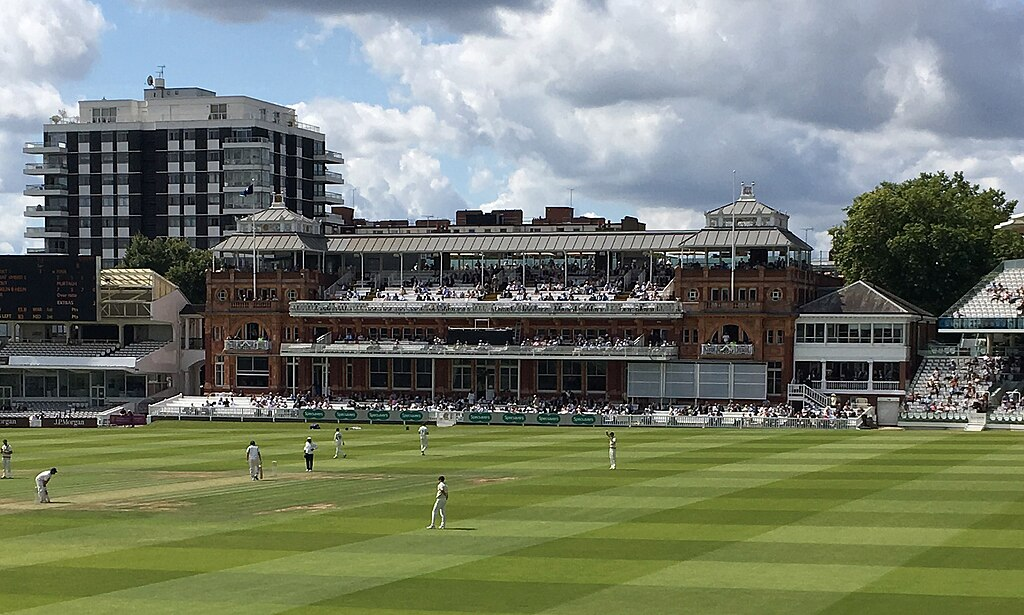
In the heart of St. John’s Wood, London, stands a ground that transcends sport itself. Lord’s Cricket Ground is not merely a venue where cricket is played—it is cricket’s beating heart, its spiritual home, and the keeper of its most sacred traditions. For over two centuries, this hallowed turf has witnessed the greatest moments in cricket history, earning its reverence as “The Home of Cricket.”
The Sacred Turf
The very ground beneath players’ feet carries an almost mystical significance. The Lord’s pitch, meticulously maintained and steeped in tradition, has been the stage for countless epic battles. From legendary Ashes encounters to World Cup finals, the 22 yards of carefully tended grass have seen empires rise and fall, careers made and broken, and moments that have defined the sport for generations.
What makes Lord’s pitch truly special is not just its quality, but its character. The famous slope—a gentle gradient of two and a half feet from the Pavilion End to the Nursery End—adds a unique dimension to the game. This natural quirk has confounded batsmen and aided bowlers for generations, becoming as much a part of Lord’s folklore as any human participant.
The Cathedral of Cricket Architecture
The ground’s architecture tells the story of cricket’s evolution. The iconic Victorian Pavilion, with its distinctive red-brick facade and Long Room, stands as a monument to cricket’s golden age. Built in 1890, it remains the spiritual center of the ground, where members in their distinctive egg-and-bacon ties gather to watch the action unfold.
The famous Lord’s balcony, where victorious teams celebrate and defeated ones contemplate, has become one of sport’s most recognizable stages. The sight of players lifting trophies against the backdrop of the historic Pavilion is an image that resonates far beyond cricket’s boundaries.
The Media Centre, a striking modern addition that won the Royal Institute of British Architects’ Stirling Prize, demonstrates how Lord’s has evolved while maintaining its essential character. This aluminum pod, seemingly floating above the ground, represents cricket’s embrace of the modern age without abandoning its roots.
The Curator of Cricket’s Greatest Treasures
Lord’s houses the MCC Museum, the world’s oldest sporting museum, which serves as cricket’s memory bank. The original Ashes urn—that tiny terracotta vessel that represents cricket’s most famous rivalry—resides here alongside countless other artifacts that tell the sport’s story. From W.G. Grace’s bat to modern memorabilia, the museum preserves cricket’s heritage for future generations.
The ground’s collection extends beyond objects to include the very essence of cricket tradition. The famous Lord’s honours boards in the pavilion record the names of those who have achieved greatness on this ground—centuries, five-wicket hauls, and match-winning performances that have earned players immortality in cricket folklore.
Where Giants Walked
Lord’s has been graced by every great name in cricket history. Sir Don Bradman played his final Test here in 1948, walking off to a standing ovation that lasted several minutes. Sir Ian Botham produced one of cricket’s greatest all-round performances in the 1981 Ashes. Shane Warne bowled his “Ball of the Century” to Mike Gatting. Kapil Dev lifted the World Cup in 1983, changing cricket’s landscape forever.
The ground has witnessed perfect games, including Jim Laker’s 19 wickets in a match against Australia in 1956—a record that stands to this day. It has seen the rise of cricket’s greatest dynasties and the fall of seemingly invincible teams. Each match adds another layer to Lord’s rich tapestry of stories.
The Keeper of Traditions
Lord’s embodies cricket’s greatest traditions. The ringing of the five-minute bell before play begins, the hushed reverence of the Long Room, the strict dress codes, and the unwritten rules of behavior all contribute to an atmosphere unlike any other sporting venue. These traditions are not mere ceremony—they are the living embodiment of cricket’s values and heritage.
The ground’s members, some of whom wait decades for the privilege of membership, serve as guardians of these traditions. Their passionate devotion to the game and its customs ensures that Lord’s maintains its unique character in an increasingly commercialized sporting world.
A Global Pilgrimage
For cricketers worldwide, playing at Lord’s represents the pinnacle of achievement. The opportunity to walk through the Long Room, past portraits of cricket’s immortals, and onto the famous turf is a dream that transcends nationality, generation, and playing ability. Many describe it as a spiritual experience—a connection to something greater than themselves.
International players speak of the unique pressure and privilege of playing at Lord’s. The ground’s atmosphere, history, and significance can elevate ordinary players to extraordinary heights while humbling the greatest champions. It is a place where reputations are made and legends are born.
The Modern Colosseum
Today’s Lord’s successfully balances tradition with innovation. The ground has embraced technology while maintaining its essential character. The historic pavilion stands alongside modern facilities, creating a unique blend of old and new that reflects cricket’s own evolution.
Major matches at Lord’s still stop the cricket world. The ICC Cricket World Cup final, The Ashes, and England’s home Tests draw global audiences who tune in not just for the cricket, but for the spectacle of the world’s most famous cricket ground in action.
Beyond the Boundary
Lord’s influence extends far beyond the boundary rope. As the headquarters of the Marylebone Cricket Club (MCC), it serves as the guardian of cricket’s laws and traditions. The MCC’s role in developing and maintaining the Laws of Cricket means that decisions made at Lord’s affect the game at every level, from village greens to international arenas.
The ground’s coaching facilities, led by the MCC Cricket Academy, help develop the next generation of cricketers. The combination of world-class facilities and the inspiration of playing at cricket’s most famous venue creates an environment where young players can dream of future glory.
The Eternal Stage
As cricket continues to evolve—with new formats, technologies, and global expansion—Lord’s remains the sport’s constant. It is the place where cricket’s past, present, and future converge. Every match played there adds to its legend, every great performance becomes part of its story, and every player who walks onto its turf becomes part of its eternal narrative.
Lord’s Cricket Ground is more than a sporting venue—it is cricket’s soul made manifest in brick, mortar, and perfectly manicured grass. It stands as proof that some places transcend their physical boundaries to become something greater: symbols of human achievement, repositories of shared memory, and guardians of sporting immortality.
In a world where sporting venues are increasingly corporate and generic, Lord’s remains gloriously, defiantly itself—a place where history lives, legends are born, and the beautiful game of cricket finds its truest expression. It is, and always will be, the Home of Cricket.




